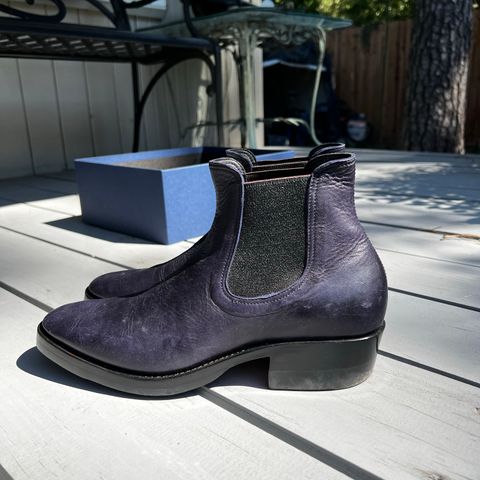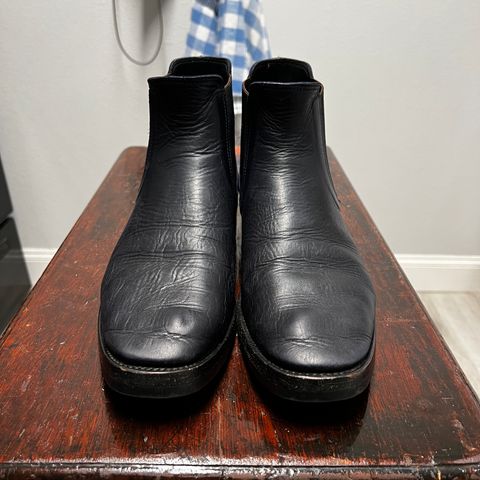About
Shinki Purple Latigo Horsehide is a color variant of latigo horsehide leather produced by Shinki Hikaku, a Japanese tannery specializing exclusively in horse leather since 1951. Purple represents an uncommon color option in the latigo horsehide format, with Shinki's purple offerings more commonly documented in their shell cordovan production under the name Amethyst.
About
Shinki Purple Latigo Horsehide is a color variant of latigo horsehide leather produced by Shinki Hikaku, a Japanese tannery specializing exclusively in horse leather since 1951. Purple represents an uncommon color option in the latigo horsehide format, with Shinki's purple offerings more commonly documented in their shell cordovan production under the name Amethyst.
Latigo Horsehide combines chrome and vegetable tanning processes to create a heavyweight, durable leather traditionally used for belts and straps. When produced by Shinki Hikaku, the material undergoes natural air drying and aging stages lasting up to four months, resulting in distinctive texture and grain characteristics.
Production and Tanning
Shinki Hikaku produces latigo horsehide through a combination tanning process. The leather first undergoes chrome tanning using acidic salt solutions, followed by vegetable tanning in progressively stronger tanning solutions. The hides are then tumbled in drums to absorb oils and waxes, creating the characteristic latigo finish.
The tannery uses tannin tanning in pits, with each hide receiving months-long treatment to develop the leather's glossy appearance. This process involves soaking in liquor of bark and water imported from Australia using mimosa tannage techniques passed down through generations. Hides are sourced from the loin area to the rump of horses, providing the light weight and suppleness characteristic of Shinki's horsehide production.
Characteristics
Purple latigo horsehide shares the core properties of traditional latigo leather. The material is extra heavyweight and full grain, with low flexibility compared to other horsehide formats. Despite its rigidity, the leather quickly becomes soft with use while maintaining high durability.
The leather exhibits moisture and sweat resistance, though it can bleed color when wet and is not suitable for stamping or tooling. The combination tanning process creates leather more rigid than full chrome-tanned material but less rigid than pure vegetable-tanned leather.
Shinki's horsehide demonstrates a polished luster with less waxy feel compared to horsehide from other tanneries. The material maintains the natural grain and texture of the horse hide, with authentic marks from the animal's life remaining visible. The dense grain provides added durability and resistance to wear.
Aging and Patina
Latigo horsehide develops patina over time through exposure to natural elements including sunlight and moisture. Full grain leather, when properly maintained, develops rich patina that adds individual character to each piece. The tannin tanning process creates leathers that retain the grain and texture of the animal hide, which becomes more pronounced as patina develops.
Purple-colored leather in heritage footwear applications can show patina evolution, with the combination of oils, waxes, and use creating variations in tone and depth. The aging process requires appropriate care, with some pull-up leathers benefiting from avoiding polish or wax to allow natural patina development.
Color Production
While Shinki Hikaku produces purple leather primarily in their shell cordovan format under the Amethyst designation, the tannery's capabilities in color production extend across their horsehide offerings. Traditional latigo has been manufactured predominantly in burgundy, but production includes black, shades of brown and red, and lighter colors including purple variants.
The purple shell cordovan from Shinki uses 100 percent mimosa tannins in the tannage process, traditionally and carefully tanned to create the distinctive coloration. This same approach to color application could be extended to latigo horsehide production, though specific purple latigo horsehide examples in finished footwear products remain limited in documented sources.
Company Background
Shinki Hikaku operates as the only tannery globally to specialize exclusively in horse leather. Located in Himeji City, Hyogo Prefecture, Japan, the family-run business was established in 1951 and has maintained traditional tanning techniques while achieving modern environmental certifications including Leather Working Group Gold status.
The tannery conducts full integrated production from tanning through finishing, processing raw hides imported from Europe. Production cycles take up to four months, with approximately 30 percent of hide volume lost during the curing and shrinking stages of the process.
References
"Service Boot Horsehide Latigo". Viberg. Retrieved October 11, 2025.
"What Is Latigo Leather?". BestLeather.org. Retrieved October 11, 2025.
"Horse-Hide". Shinki Hikaku. Retrieved October 11, 2025.









































